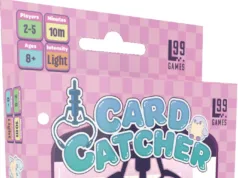 Like me, you’ve probably experienced the anxiety of attending a party or a dance and desperately hoping to catch the attention of a special someone. Stolen glances from across the room. Brief smiles as your gazes meet. Or, apparently, standing in long receiving lines hoping for a few seconds to chat with the person and see if your symbols match theirs I guess?
Like me, you’ve probably experienced the anxiety of attending a party or a dance and desperately hoping to catch the attention of a special someone. Stolen glances from across the room. Brief smiles as your gazes meet. Or, apparently, standing in long receiving lines hoping for a few seconds to chat with the person and see if your symbols match theirs I guess?
Regardless of how strong the theme comes through, that’s the general vibe that Belle of the Ball is looking to convey. It was designed by Daniel Solis with great artwork by Jacqui Davis.
Gameplay Overview:
Belle of the Ball is a set collection and drafting game for 2 to 5 players that plays pretty quickly in about 30 minutes. At the start of the game, each player will be given three random guest cards, a single belle card, and three regret cards. (The regrets are effectively the game’s currency, which feels like it should be the name of an emo song… “Regrets Are Currency,” “Paying With Regret,” or something. You get the idea.) At the center of the table will be two lines of cards. One line is the guest line, which is the main way players will score points throughout the game. Each guest will be drafted and added to one group in the party in front of you.

The second line is the belle line. This line consists of five power cards that players can also draft to use on their turn. There are three types of these cards: cards that have an immediate impact on the game state, cards that can be played into your own tableau with varying effects, and cards that can be played on opponents’ tableaus with varying effects. Thematically, this signifies the varying moods of the belle; she either feels like giving out mirth, mischief, or mayhem. (Because Theme!)
Each turn, players first have the option of drafting a card from either receiving line. The first card in the line is always free but to acquire cards further down the line, players will have to put a regret next to each card they pass. If they take a guest card it immediately gets added to one of the three groups in their party. If they take a belle card, they can save that card to play during the second phase of any of their turns. Whenever a player selects a guest or belle card with regrets next to it, they also acquire the regrets and can use them later.
Once a group has four cards in it (including belle cards) it immediately scores. Players score one point for each matching symbol in the group, although many of the belle cards modify this in positive or negative ways. The game lasts until all the guests from the entire deck—coat room? parking lot? vague theme location?—have been sent to parties. The player with the most points had the best party within the party (maybe?) and is the winner.

Game Experience:
Belle of the Ball is an incredibly light set collection game. There are a few modules players can add that will change things slightly but for the most part, players are always looking for symbols that match the groups they already have in front of them. Occasionally it makes sense to peek around the table and see if bothering someone else’s plan is worthwhile, but often it isn’t. No matter what you draft, however, players are effectively always going to score somewhere in the same range of points when the groups finally do score.

The belle cards are both an interesting complication to the traditional set collection aspect and also a frustrating design choice. A few of them simply seem overpowered (like the belle card that allows players to build groups larger than four) while others are far too “take that” in their nature. Targeting a single player with a negative card feels like a design choice that would have been made in an older game and not one this modern.
The good news is that the game is very easy to pick up and play and deciding when to spend one’s regrets is a decent strategic concept at lower player counts. Currency is hard to come by, so players have to make the right move at the right time or risk getting stuck without any regrets to spend, which can stall out their decision space for a few turns. With the full complement of players, however, the receiving line changes so drastically from one turn to the next that basically, the only strategy is to always spend every regret to get the best card available.

The theme isn’t really tied too closely to the mechanics of the game—there are multiple balls competing with each other by pulling attendees from the same line of guests?—but the artwork does help the general mood of the game. Many of the characters do look like they belong on this vague fancy island where the game takes place in. One thing that doesn’t work is the names that were chosen to represent the characters. Most of them are odd attempts at humor that I found fell very flat. (A sampling of some of the names: Underpants Unterdaria, Gigglelack Lololol, Bumblebee Bindlemeg, Gapplesap Gravelsap, and Fffffffff Flippinbird. I don’t know what they were going for, but every character is essentially named this way and none of them are funny.)
Final Thoughts:
I don’t want this review to sound overly negative as I did have some fun playing Belle of the Ball. There just isn’t a whole lot of game here and it feels like other set collection games do this style of play better without being that much more complex. Still, this is meant to be somewhere between a light strategy game and a party game, and in that way, it kinda sorta works. It does run a little long for it to fully work as a party game though and it’s probably a bit too chaotic to function as anything other than that.
Final Score: 2.5 Stars. A breezy and pleasant party experience that is unlikely to be as memorable as the best ball you’ve ever been to.
 Hits:
Hits:
• Great artwork
• Easy to play
Misses:
• Too much take that
• Given its simplicity, it goes on too long
• Not much strategic differences from game to game
• What is up with those character names?






















